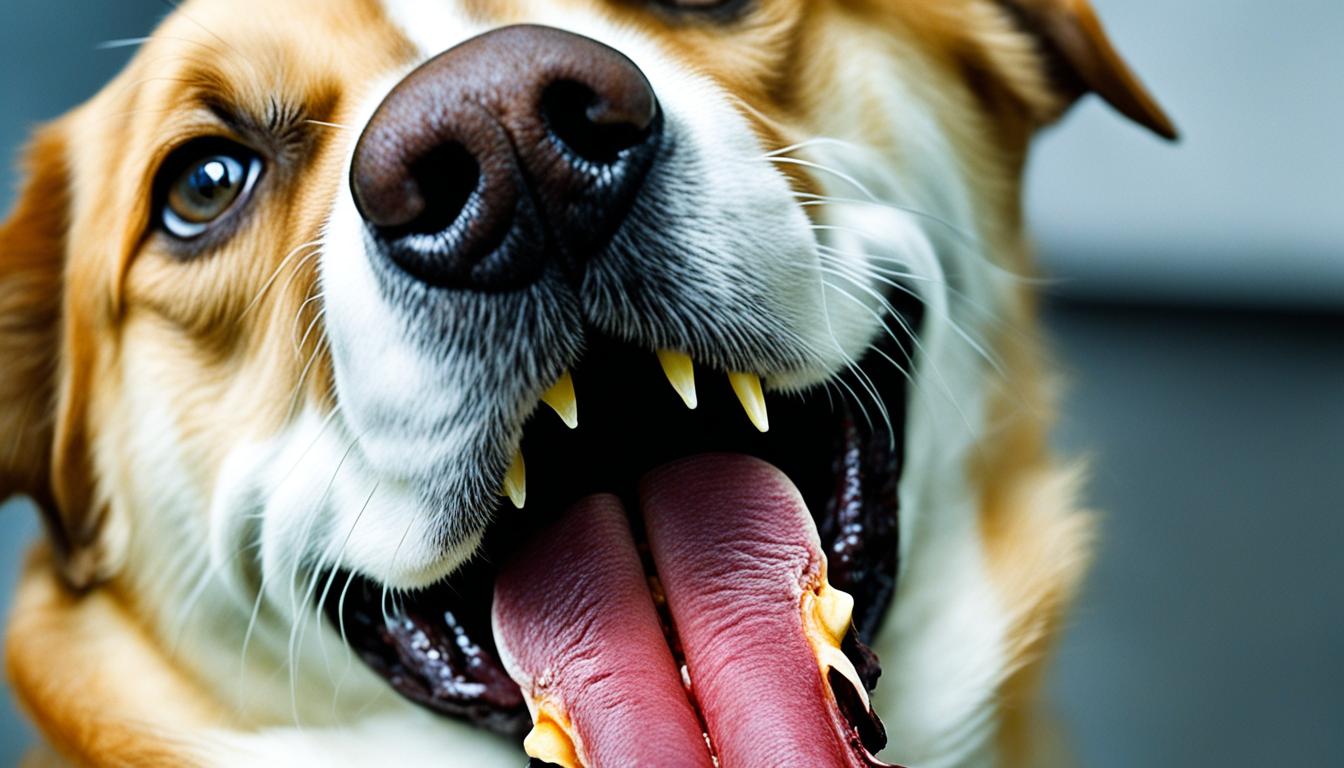Megaesophagus is a challenging disorder in dogs that affects the esophagus, making it difficult for food and liquid to pass into the stomach. While more common in dogs than cats, it can be hereditary in certain breeds such as Wire Haired Fox Terriers and Miniature Schnauzers. Regurgitation is the primary symptom, and other signs may include bad breath, pneumonia, and muscle weakness. The causes of megaesophagus can vary, ranging from nerve and muscle damage to inflammation, blockage, and hormonal diseases.
Diagnosis is typically done through radiographs, and treatment focuses on managing symptoms and preventing regurgitation. Unfortunately, the prognosis for dogs with megaesophagus is generally poor, with malnutrition and aspiration pneumonia being common complications. However, early diagnosis, appropriate management, and supportive care can improve the quality of life for affected dogs.
Key Takeaways:
- Megaesophagus is a disorder that affects the esophagus in dogs, making it difficult for food and liquid to pass into the stomach.
- It is more common in dogs than cats and can be hereditary in certain breeds.
- Regurgitation is the primary symptom, and other signs may include bad breath, pneumonia, and muscle weakness.
- The causes of megaesophagus can vary, including nerve and muscle damage, inflammation, blockage, and hormonal diseases.
- Diagnosis is typically done through radiographs, and treatment focuses on managing symptoms and preventing regurgitation.
- The prognosis for dogs with megaesophagus is generally poor, but early diagnosis, appropriate management, and supportive care can improve quality of life.
Understanding Megaesophagus in Dogs
Megaesophagus is a disorder of the canine esophagus that affects a dog’s ability to swallow and transport food to the stomach. In order to properly identify and manage megaesophagus, it is crucial to understand the difference between regurgitation and vomiting.
Regurgitation is a passive process where food is released back up without heaving or retching. It often appears as undigested food or liquid being expelled from the esophagus. On the other hand, vomiting is an active process characterized by gagging and heaving, usually accompanied by bile or stomach contents.
Megaesophagus can be either congenital, present from birth, or acquired later in life. It is more common in dogs than cats, and certain breeds may have a higher predisposition to developing the condition. Understanding the underlying causes and distinguishing between regurgitation and vomiting are essential steps in the diagnosis and management of megaesophagus.
For a visual representation of the canine esophagus, refer to the illustration below:
Causes of Megaesophagus in Dogs
The exact cause of megaesophagus in dogs is often unknown, but several factors can contribute to its development. Megaesophagus can be classified into two categories: congenital megaesophagus, which is present at birth, and acquired megaesophagus, which develops later in life.
Congenital Megaesophagus
Congenital megaesophagus is typically hereditary and can affect certain breeds such as Great Danes, Irish Setters, and German Shepherds. Puppies are born with an underdeveloped esophagus, resulting in difficulties in swallowing and food passage. This developmental disorder is believed to be caused by incomplete nerve development in the esophagus.
Acquired Megaesophagus
Acquired megaesophagus can occur due to various factors. Damage to the esophagus, which may be caused by trauma or surgical procedures, can impede its functionality, leading to megaesophagus. Inflammation of the esophagus, known as esophagitis, can also contribute to the development of the condition.
Hormonal diseases, such as Addison’s disease and hypothyroidism, can affect the motility of the esophagus and result in megaesophagus. Additionally, exposure to toxins, such as certain medications, can lead to the development of acquired megaesophagus.
| Causes of Megaesophagus | Symptoms |
|---|---|
| Congenital Megaesophagus | Difficulty swallowing, regurgitation, slow growth, weight loss |
| Acquired Megaesophagus | Regurgitation, weight loss, bad breath, aspiration pneumonia |
Identifying the underlying cause of megaesophagus is crucial in determining the most appropriate treatment approach and prognosis for affected dogs. A thorough evaluation by a veterinarian, including imaging tests and medical history review, can help uncover any potential contributing factors.
In the next section, we will explore the symptoms and diagnostic methods used to identify megaesophagus in dogs.
Symptoms and Diagnosis of Megaesophagus in Dogs
Megaesophagus in dogs is characterized by regurgitation, where food and water accumulate in the esophagus and are passively expelled. This is the most common symptom observed in dogs with megaesophagus. In addition to regurgitation, other symptoms that may indicate the presence of megaesophagus include bad breath, signs of pneumonia, muscle weakness, and weight loss.
Diagnosing megaesophagus in dogs requires a thorough evaluation. The initial step in diagnosis is usually radiographic imaging, specifically radiographs or X-rays. These images can reveal the dilated esophagus and the displacement of the trachea, providing valuable insights into the condition. The radiographic diagnosis of megaesophagus is a crucial component in confirming the presence of the condition.
If necessary, contrast studies or additional diagnostic tests may be conducted to further evaluate the esophagus and identify any underlying causes. Contrast studies involve the use of a contrast medium, such as barium, which helps outline the esophagus and highlight any abnormalities. These studies aid in identifying blockages, strictures, or other structural issues that may be contributing to the megaesophagus.
Early diagnosis and timely treatment play a vital role in effectively managing megaesophagus and preventing complications such as aspiration pneumonia.
While radiographic diagnosis and contrast studies are key in identifying megaesophagus, it is essential to consider the overall clinical picture and assess any potential underlying causes. The diagnostic approach may include a comprehensive evaluation of the dog’s medical history, physical examination findings, and the presence of any concurrent conditions or diseases that could contribute to the megaesophagus.
By combining clinical observations, radiographic diagnosis, contrast studies, and thorough testing, veterinarians can accurately diagnose megaesophagus in dogs and develop an appropriate treatment plan to manage the condition effectively.
Key Points:
- The most common symptom of megaesophagus in dogs is regurgitation.
- Other symptoms may include bad breath, signs of pneumonia, muscle weakness, and weight loss.
- Diagnosing megaesophagus is typically done through radiographic imaging.
- Contrast studies and additional diagnostic tests may be conducted to evaluate the esophagus and identify underlying causes.
- Early diagnosis and treatment are important in managing megaesophagus and preventing complications.
Treatment Options for Megaesophagus in Dogs
Treatment of megaesophagus in dogs focuses on managing the symptoms and preventing regurgitation. Various strategies can be employed to help facilitate food passage into the stomach and ensure adequate nutrition.
Feeding Methods
Feeding methods play a crucial role in treating megaesophagus. Here are some management strategies:
- Feeding in an upright position: This helps gravity facilitate food movement down the esophagus.
- Using a Bailey chair: This specially designed chair helps dogs maintain an upright feeding position, minimizing regurgitation.
- Feeding small, frequent meals: This reduces the volume of food in the esophagus, making it easier to swallow and reducing the likelihood of regurgitation.
Adjusting food consistency can also help reduce regurgitation. Some dogs with megaesophagus respond better to solid foods, while others may benefit from liquid diets. It’s important to work with a veterinarian to determine the most appropriate feeding plan for each individual dog.
Gastric Feeding Tube
In severe cases of megaesophagus, a gastric feeding tube may be necessary to ensure adequate nutrition. This tube is inserted directly into the stomach, bypassing the esophagus. It allows for the delivery of food and medications directly into the stomach, reducing the risk of regurgitation.
Medications
Sildenafil, a medication that relaxes the muscles of the esophagus, may be used to improve esophageal function in dogs with megaesophagus. Botox injections can also be beneficial in some cases. These treatments aim to enhance esophageal motility and reduce regurgitation.
Managing Complications
Regular monitoring and management of complications, such as aspiration pneumonia, are crucial in the long-term care of dogs with megaesophagus. Aspiration pneumonia is a risk when regurgitated food or liquid enters the respiratory tract. Close veterinary supervision, prompt treatment of respiratory infections, and preventive measures can help minimize the risk of complications and support the overall well-being of dogs with megaesophagus.
| Treatment Options | Description |
|---|---|
| Feeding methods | Feeding in an upright position, using a Bailey chair, and feeding small, frequent meals |
| Gastric feeding tube | A tube inserted directly into the stomach to ensure adequate nutrition |
| Medications | Sildenafil and Botox injections to improve esophageal function |
| Managing complications | Regular monitoring and treatment of aspiration pneumonia |
Proper treatment and management strategies can help improve the quality of life for dogs with megaesophagus and minimize the risk of complications. It’s important to work closely with a veterinarian to develop an individualized treatment plan that addresses the specific needs of each dog.
Prognosis and Long-Term Outlook for Dogs with Megaesophagus
When it comes to dogs with megaesophagus, the prognosis is generally poor, and there are several factors that contribute to this challenging condition. Two of the leading causes of death in dogs with megaesophagus are malnutrition and aspiration pneumonia, prognosis for megaesophagus, complications of megaesophagus. Malnutrition occurs because the esophagus is dilated and loses its motility, making it difficult for food and liquid to pass into the stomach. This can result in inadequate nutrient intake, leading to weight loss and weakness. Aspiration pneumonia is another significant complication as regurgitated material can enter the respiratory system, causing inflammation and infection in the lungs.
The long-term outlook for dogs with megaesophagus depends on various factors, including the underlying cause and the effectiveness of treatment, long-term outlook. One important consideration is whether the megaesophagus is caused by a treatable condition, such as myasthenia gravis, a neuromuscular disease that affects the function of the esophagus. If the underlying issue can be resolved, there is a possibility of improving esophageal function and managing the condition more effectively.
Regular monitoring and management of the complications associated with megaesophagus are vital, complications of megaesophagus. This includes ongoing assessment of the dog’s nutritional status, ensuring proper feeding techniques, and providing supportive care. Aspiration pneumonia should be promptly diagnosed and treated, as it can significantly impact a dog’s respiratory health. With diligent care and attention, the long-term outlook for dogs with megaesophagus can be improved, aiming to optimize their quality of life.
Congenital Megaesophagus in Dogs
Congenital megaesophagus is a developmental disorder that affects puppies and is present at birth. It is often seen in certain breeds, such as Wire Haired Fox Terriers and Miniature Schnauzers. Puppies with congenital megaesophagus typically start regurgitating when they begin eating solid food. The condition is believed to be caused by incomplete nerve development in the esophagus.
While the prognosis for congenital megaesophagus can be better than acquired megaesophagus, proper management and treatment are still necessary to ensure the health and well-being of affected puppies.
Key Points:
- Congenital megaesophagus is a developmental disorder present at birth in puppies.
- It is more commonly observed in breeds such as Wire Haired Fox Terriers and Miniature Schnauzers.
- Puppies with congenital megaesophagus experience regurgitation when they begin eating solid food.
- The condition is believed to result from incomplete nerve development in the esophagus.
- Suitable management and treatment are crucial for the well-being of puppies with congenital megaesophagus.
Breeds Predisposed to Congenital Megaesophagus
| Breed | Prevalence |
|---|---|
| Wire Haired Fox Terrier | High |
| Miniature Schnauzer | High |
| Other Breeds | Less Common |
Acquired Megaesophagus in Dogs
Acquired megaesophagus in dogs is a condition that develops later in life, typically affecting young adults or middle-aged animals. Unlike congenital megaesophagus, which is present at birth, acquired megaesophagus can be acquired later in life due to various factors. The exact cause of acquired megaesophagus can be multifactorial, and it is often secondary to other diseases or conditions.
Causes of Acquired Megaesophagus:
Acquired megaesophagus in dogs can arise due to several underlying causes, including:
- Myasthenia gravis: This autoimmune disorder affects the transmission of nerve signals to the muscles, leading to weakness, including in the esophagus.
- Esophageal blockage: Any obstruction or narrowing of the esophagus can interfere with the normal movement of food, resulting in dilation and dysfunction.
- Hormonal diseases: Certain hormonal imbalances, such as hypothyroidism, can contribute to the development of acquired megaesophagus.
Identifying the underlying cause of acquired megaesophagus is crucial in determining the appropriate treatment approach for affected dogs. Diagnostic tests, such as blood work and imaging studies, may be necessary to diagnose the underlying condition causing acquired megaesophagus.
The treatment of acquired megaesophagus in dogs focuses on managing the symptoms and improving the overall quality of life for affected animals. While there is no cure for the condition, various treatment options can help alleviate the symptoms and prevent complications.
Management strategies for acquired megaesophagus may include:
- Feeding techniques: Modifying the feeding process by providing small, frequent meals and elevating the dog’s food bowl can help facilitate better food passage into the stomach.
- Diet adjustments: The consistency and texture of the food may need to be modified to reduce the risk of regurgitation. Some dogs may respond better to solid foods, while others may require a soft or liquid diet.
- Medications: Depending on the underlying cause, medications such as those aimed at improving esophageal motility or managing the underlying condition (e.g., immunosuppressive drugs for myasthenia gravis) may be prescribed.
- Gastric feeding tubes: In severe cases where oral feeding is not possible, a gastric feeding tube may be inserted to ensure adequate nutrition.
Regular monitoring and follow-up visits with a veterinarian are essential for dogs with acquired megaesophagus to assess their overall condition, manage complications, and adjust treatment strategies as needed. Although the prognosis for acquired megaesophagus is generally poor, proper management and treatment can help improve the quality of life for affected dogs.
Diagnostic Tests for Megaesophagus in Dogs
Diagnosing megaesophagus in dogs involves a comprehensive approach utilizing various diagnostic tests. Radiography or X-rays are commonly employed to visualize the dilation of the esophagus and the displacement of the trachea, aiding in the identification of megaesophagus. During this process, a contrast medium, such as barium, can be introduced to enhance the visibility of the esophagus and detect any abnormalities. This technique, known as radiographic contrast studies, provides a detailed view of the esophageal structure and function.
While specific blood tests for megaesophagus are not available, other diagnostic procedures may be conducted to determine the underlying cause, if possible. Fluoroscopy, a real-time X-ray imaging technique, can be employed to assess the movement and functionality of the esophagus during swallowing. Endoscopy, which involves inserting a flexible tube with a camera into the esophagus, allows for a direct visualization and examination of the esophageal lining.
Electrical tests, such as esophageal manometry, are utilized to evaluate the muscular activity and coordination of the esophagus. Muscle biopsies may also be performed to identify any muscle abnormalities that could contribute to megaesophagus. In certain cases, the evaluation of the cerebrospinal fluid may be recommended to assess for potential neurological causes.
Here is an example table that summarizes the diagnostic tests for megaesophagus in dogs:
| Diagnostic Test | Description |
|---|---|
| Radiography | X-ray imaging to visualize esophageal dilation and tracheal displacement. |
| Radiographic Contrast Studies | Introduction of contrast medium to enhance visibility and identify abnormalities. |
| Fluoroscopy | Real-time X-ray imaging to assess esophageal movement and functionality. |
| Endoscopy | Direct visualization and examination of the esophageal lining using a flexible tube with a camera. |
| Electrical Tests (Esophageal Manometry) | Evaluation of esophageal muscular activity and coordination. |
| Muscle Biopsy | Sampling of esophageal muscle to identify abnormalities. |
| Evaluation of Cerebrospinal Fluid | Assessment for potential neurological causes of megaesophagus. |
Here is an example image that showcases the process of radiographic contrast studies:
The diagnostic process for megaesophagus in dogs involves a combination of these tests to ensure an accurate diagnosis and to identify any associated conditions or underlying causes. Through these diagnostic measures, veterinarians can determine an appropriate treatment plan and management strategies to improve the quality of life for dogs with megaesophagus.
Managing Megaesophagus in Dogs
Managing megaesophagus in dogs involves a combination of treatment strategies to prevent regurgitation and aspiration pneumonia. By implementing appropriate management techniques, pet owners can improve their dog’s quality of life and overall well-being.
Treatment Strategies
One of the key treatment strategies for managing megaesophagus is adjusting the feeding method. Feeding the dog in an upright position can help facilitate the passage of food into the stomach. This can be achieved by using a specially designed Bailey chair, which keeps the dog in an elevated position during mealtimes. Feeding the dog smaller, more frequent meals throughout the day can also help reduce the chances of regurgitation.
Adjusting the consistency of the dog’s food may also be beneficial. Some dogs with megaesophagus respond better to solid foods, while others may do better with liquefied meals. Experimenting with different food consistencies can help determine what works best for the individual dog.
Gastric Feeding Tubes
In severe cases of megaesophagus, the use of a gastric feeding tube may be necessary to ensure the dog receives adequate nutrition. A gastric feeding tube is a medical device that is placed directly into the stomach, allowing food to bypass the esophagus. This method ensures that the dog is provided with essential nutrients while minimizing the risk of regurgitation and aspiration pneumonia. It is important to consult with a veterinarian to determine if a gastric feeding tube is appropriate for the dog’s specific needs.
Preventing Aspiration Pneumonia
Preventing aspiration pneumonia is crucial in the management of megaesophagus. Aspiration pneumonia occurs when food, liquid, or foreign objects are inhaled into the lungs. To minimize the risk of aspiration pneumonia, it is important to closely monitor the dog during and after mealtime. Avoiding activities that may induce vomiting, such as intense exercise or stress, can also help reduce the chances of aspiration.
Regular veterinary check-ups are essential in managing megaesophagus. These appointments allow for the monitoring of the dog’s condition and adjustment of treatment strategies as needed. By following a comprehensive management plan, pet owners can provide their dogs with the best possible care and improve their overall quality of life.
| Treatment Strategies | Advantages | Considerations |
|---|---|---|
| Feeding in an upright position using a Bailey chair | Aids in food passage into the stomach | May require specific training and supervision |
| Feeding smaller, more frequent meals | Reduces the chances of regurgitation | May require adjustments to the dog’s routine |
| Adjusting food consistency | Finds the optimal consistency for the individual dog | May require experimentation and guidance from a veterinarian |
| Using a gastric feeding tube | Ensures adequate nutrition while minimizing regurgitation | Requires veterinary consultation and proper insertion technique |
| Closely monitoring the dog during and after mealtime | Reduces the risk of aspiration pneumonia | Requires attention and observation |
Surgical Options for Megaesophagus in Dogs
In some cases, surgical intervention may be considered as a surgical treatment for megaesophagus. These surgical procedures are designed to improve esophageal function and reduce regurgitation in affected dogs.
The specific surgical options for megaesophagus in dogs may vary depending on the individual case and underlying cause of the condition. Surgical procedures can involve correcting anomalies or removing obstructions in the esophagus to facilitate the passage of food and liquids into the stomach.
It is important to note that surgery is not considered a complete cure for megaesophagus in dogs. While surgical interventions can improve esophageal function and reduce regurgitation, regular management and monitoring of the condition are still necessary to ensure the best possible outcomes for affected dogs.
The decision to pursue surgical options should be made in consultation with a veterinarian. The veterinarian will assess the individual needs and health of the dog to determine the appropriateness of surgical treatment for megaesophagus.
Conclusion
Megaesophagus is a challenging condition that significantly affects the quality of life of dogs, as it impairs their ability to swallow and transport food to the stomach. Dogs with megaesophagus are at risk of complications such as malnutrition and aspiration pneumonia. Early detection, proper management, and appropriate treatment strategies are essential in improving outcomes for these dogs.
By implementing feeding methods, adjusting food consistency, and utilizing feeding tubes when necessary, the symptoms of megaesophagus can be managed. Regular monitoring and proactive measures can help prevent complications and ensure a higher quality of life for affected dogs.
Although there is no complete cure for megaesophagus, providing the necessary care and support can significantly improve the overall well-being of dogs with this condition. With proper diagnosis, treatment, and ongoing attention to their needs, dogs with megaesophagus can lead fulfilling lives despite the challenges they face.







